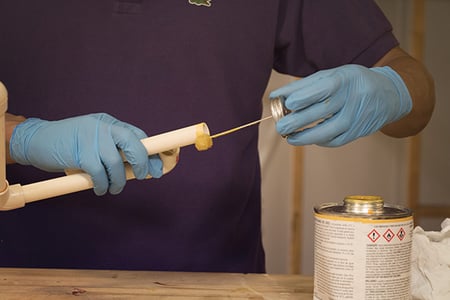
Understanding FlowGuard® Plus CPVC Pipe Joining Methods
What do you Connect FlowGuard® Plus CPVC piping systems with and why?
Installation is a significant factor in the time it takes to complete a project, the long-term reliability of the plumbing system, and the overall job cost. Each of these factors contributes to your ability to win a plumbing job, and remain profitable.
For this reason, plumbers can benefit by being more proactive with their piping material recommendations to home and building owners.
Material Joining Methods
Many plastic and metal plumbing pipes are joined together using heat fusion. In other words, the piping ends are heated to a melting point, pushed together, and then allowed to cool. While a reliable joint is created, the seam is not as strong as the material itself.
FlowGuard® Plus CPVC piping systems are assembled using solvent cement. Solvent cement chemically fuses the pipe and fittings together at the molecular level, creating one continuous piece of plastic. The resulting seam becomes the strongest part of the entire system.
Why the Joining Method Matters
1. Required Tools
To install FlowGuard® Plus CPVC pipes with solvent cement, all a contractor needs is a can of solvent cement and a dauber less than half the width of the pipe opening. This allows for fast, consistent application of the solvent cement, even in confined, hard to reach areas.

Conversely, alternative plastic and metal piping requires an electricity source readily available, and room to effectively heat the seam all the way around.
In tight areas, the piping may actually have to be prefabricated to ensure even heat application.
2. Skill
Heat fusion requires a skilled hand. When two superheated pieces of pipe are pushed together, or a welding rod is applied, a bead of material may form around the inside of a pipe. This bead can restrict water flow, and create eddies, where microorganisms like to grow.
With solvent cement, after basic instruction, anyone can join FlowGuard® Plus CPVC piping systems. In addition, thanks to the tapered end of the pipe, the solvent cement is dispersed evenly around the joint, rather than being pushed down into the seam.
This reduces bacterial growth, doesn’t reduce the internal diameter of the pipe and ensures full flow rate.
3. Long-Term Reliability
Thanks to the solvent cement process, the joint becomes one piece of plastic that is twice as thick as the piping itself─it cannot be pulled apart or broken.
When it comes to system reliability and ultimately the reputation of the contractor, nothing is more reliable than CPVC.
Let's look at a cross-section of a joint:
A solvent cemented FlowGuard® Plus CPVC pipe is monolithic and seamless, as seen above.
If a pressure test for failure is done on this assembly, the joints will never fail. The thickness of the joint is double the pipe wall thickness; the joint is stronger than a single run of pipe.
Have Questions?
Contractors around the world have taken advantage of FlowGuard® Plus CPVC piping systems to simplify and speed up installation time as a way to increase profits and lower costs.
If you have questions about how solvent welding CPVC pipe can benefit your plumbing business, contact our team of piping systems consultants.

Prasenjit Misra
Prasenjit Misra, an accomplished professional, having extensive exposure in plumbing field, currently holds the position of Lead Demand Creation & Business Development of TempRite South Asia division at Lubrizol India.
